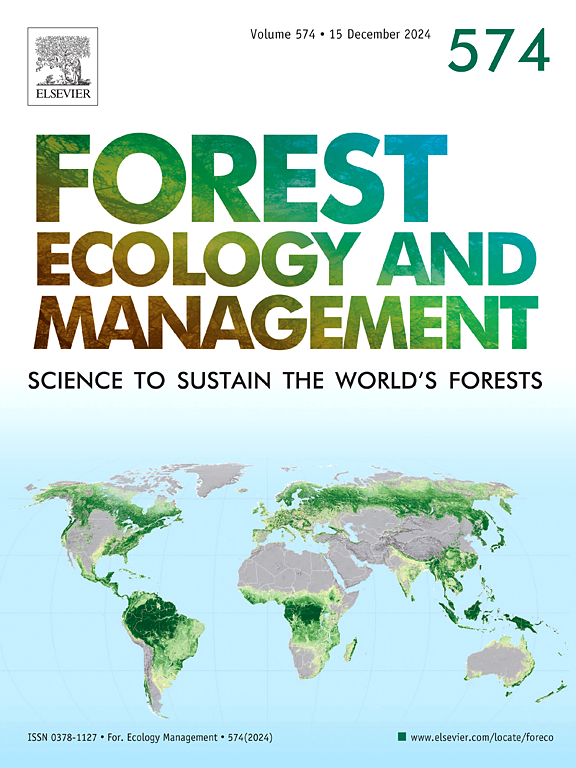Diplodia tip blight (Diplodia sapinea) and site conditions shape Scots pine (Pinus sylvestris) endophytic mycobiome
IF 3.7
2区 农林科学
Q1 FORESTRY
引用次数: 0
Abstract
Diplodia sapinea (Fr.) Fuckelis is an opportunistic pathogen of Scots pine (Pinus sylvestris (L.) that causes Diplodia tip blight following host stress. The factors driving its shift from endophyte to pathogen are not well understood, particularly in relation to the surrounding fungal community. The objective of the current study was to determine the association of D. sapinea and the composition of the general endophyte community with symptomatic and asymptomatic sites, trees, twigs and tissues in an ongoing outbreak of Diplodia tip blight. The endophytic fungal community was characterized using metabarcoding of the ribosomal ITS2 region. We found that variation in fungal community composition was most influenced by differences between sites, highlighting the importance of site-specific environmental conditions such as previous drought impact and associated crown dieback. However, the fungal communities also varied between symptomatic and asymptomatic trees indicating the significance of tree health. The fungal communities of symptomatic trees, especially in twigs with tip blight symptoms, included D. sapinea, Therrya pini, and Lophodermium arboricola. These results are consistent with the balanced antagonism hypothesis, suggesting that shifts in community composition under stress may facilitate the transition of D. sapinea from a latent endophyte to a pathogen. D. sapinea was found in both healthy and symptomatic twigs, with a ∼60-fold increase in symptomatic tissues. Site differences accounted for 42.6 % of fungal community variation. In contrast, taxa from the order Phaothecales were more abundant in asymptomatic twigs and in healthy tissues of of symptomatic twigs - suggesting potential antagonism. Our findings provide insights into early disease detection and underscore the importance of monitoring endophyte community shifts to support Scots pine forest resilience under climate stress.
苏格兰松(Pinus sylvestris)的内生真菌群落是由根尖枯萎病(Diplodia sapinea)和立地条件形成的
皂荚松(Diplodia sapinea, Fr.) Fuckelis是苏格兰松(Pinus sylvestris, L.)的一种机会致病菌,在寄主胁迫后引起皂荚松叶枯病。驱动其从内生菌转变为病原体的因素尚不清楚,特别是与周围真菌群落的关系。本研究的目的是确定在持续爆发的双plodia尖端枯萎病中,sapinea和一般内生菌群落的组成与有症状和无症状的部位、树木、树枝和组织的关系。利用核糖体ITS2区域的元条形码对内生真菌群落进行了表征。我们发现真菌群落组成的变化受不同地点的差异影响最大,强调了特定地点环境条件的重要性,如以前的干旱影响和相关的树冠枯死。然而,真菌群落在有症状树和无症状树之间也存在差异,表明树木健康的重要性。有症状树木的真菌群落,特别是在有尖端枯萎病症状的枝条上,包括sapinea、Therrya pini和Lophodermium arboricola。这些结果与平衡拮抗假说一致,表明胁迫下群落组成的变化可能促进了D. sapinea从潜伏内生菌向病原体的转变。在健康和有症状的枝条中都发现了D. sapinea,在有症状的组织中增加了~ 60倍。位点差异占真菌群落变异的42.6% %。相比之下,在无症状枝条和有症状枝条的健康组织中,phaocalles目的分类群更为丰富,表明可能存在拮抗作用。我们的研究结果为早期疾病检测提供了见解,并强调了监测内生菌群落变化对支持气候压力下苏格兰松林恢复力的重要性。
本文章由计算机程序翻译,如有差异,请以英文原文为准。
求助全文
约1分钟内获得全文
求助全文
来源期刊

Forest Ecology and Management
农林科学-林学
CiteScore
7.50
自引率
10.80%
发文量
665
审稿时长
39 days
期刊介绍:
Forest Ecology and Management publishes scientific articles linking forest ecology with forest management, focusing on the application of biological, ecological and social knowledge to the management and conservation of plantations and natural forests. The scope of the journal includes all forest ecosystems of the world.
A peer-review process ensures the quality and international interest of the manuscripts accepted for publication. The journal encourages communication between scientists in disparate fields who share a common interest in ecology and forest management, bridging the gap between research workers and forest managers.
We encourage submission of papers that will have the strongest interest and value to the Journal''s international readership. Some key features of papers with strong interest include:
1. Clear connections between the ecology and management of forests;
2. Novel ideas or approaches to important challenges in forest ecology and management;
3. Studies that address a population of interest beyond the scale of single research sites, Three key points in the design of forest experiments, Forest Ecology and Management 255 (2008) 2022-2023);
4. Review Articles on timely, important topics. Authors are welcome to contact one of the editors to discuss the suitability of a potential review manuscript.
The Journal encourages proposals for special issues examining important areas of forest ecology and management. Potential guest editors should contact any of the Editors to begin discussions about topics, potential papers, and other details.
 求助内容:
求助内容: 应助结果提醒方式:
应助结果提醒方式:


